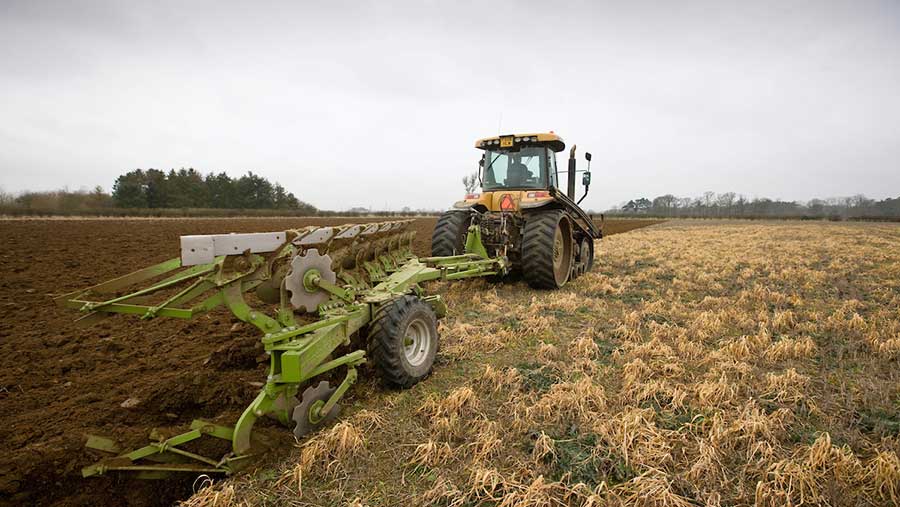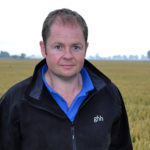5 monitor farmers share their cost saving tips
 Ploughing in winter
Ploughing in winter Slashing fuel use by 40%, producing wheat for £80/t and saving nearly £1m on machinery outlay are some of the achievements being made by Monitor Farmers across the UK.
Arable margins continue to be squeezed and while wheat and oilseed rape prices have risen in recent months, input costs are also rising.
To meet this challenge, AHDB Monitor Farmers have spent time gaining a better understanding of their own businesses and exploring different ways of reducing costs.
It’s not just costs, they have also been looking at ways of maximising yields and improving soil health.
See also: Search on for 6 arable monitor farms in England and Wales
Farmers Weekly finds out from five AHDB Monitor Farmers what they have achieved, as well as how they are planning to meet future challenges.

Richard Reed
Focusing on fixed costs: Richard Reed, Berwick-on-Tweed
A very tight rein is being kept on fixed costs at BL Farms in Northumberland, where carefully chosen second-hand machinery is helping to keep operating costs and depreciation bills down across 1,170ha of combinable crops.
Despite the average age of Richard Reed’s tractors and sprayers being 18.8 years and 17.5 years, respectively, high repair bills and breakdowns are very unusual, as all the machinery is selected for its solid construction.
As a result, he operates two 1990s Ford Versatile 946s, both with retro-fitted auto-steer. With one of them costing as little as £2.50/hour, it compares very favourably with the £35/hour cost of a more modern machine.
A total spend of just under £600,000 on equipment, which would have cost £1.5m if it was new, means that the business’s fixed costs remain significantly below those of comparative farms – even though Mr Reed moved to a 8m controlled traffic farming system in the last year.
“We may be using old equipment, but we are also adopting new techniques and ideas,” he says. “Of course, having a workforce which is able to carry out repairs and maintenance is important.”
He points out that a new 200hp tractor would have cost £31,000 in 1983, when wheat was £120/t, barley was £110/t and beans were £150/t.
“The equivalent cost today is £90,000, but commodity prices have stayed the same. So fixed costs have to be contained.”
Spending double the amount wouldn’t have guaranteed any more yield, he points out. “The age of our machinery isn’t the limiting factor, it’s management. I’d rather have an extra man than more equipment.”
Looking ahead, he hopes to reduce his horsepower requirement further by moving less soil and will use a wider rotation and different cultivations to help with weed and slug control.

Brian Barker
Benchmarking growing crops: Brian Barker, Stowmarket
A mixed bag of harvest 2016 results prompted one Suffolk grower to invest more time in recording and monitoring, in an effort to maximise production.
Having seen wheat yields vary by as much as 4.4t/ha in 2016, Brian Barker is now intent on doing more comparisons across the farm and is looking into a method of benchmarking his growing crops.
“I want to farm to my potential, not to my hope,” he explains. “So that means doing more recording throughout the season and building up my knowledge.”
As well as identifying where yield is lost, Mr Barker hopes to pinpoint the areas where he could save money on inputs. His cost of production for wheat ranged from £83-160/t last year, reflecting a £77/t difference.
Having a Yield Enhancement Network plot (a wheat yield competition) which yielded 10.3t/ha also helped to shape his thinking.
“According to Adas, the theoretical yield of that plot was 16.5t/ha, so we only managed to achieve 62% of that potential. I want to see that improve.”
The variable costs of his YEN plot were £585/ha – while on the farm he saw them range from £450-698/ha, with the average being £564/ha.
He has started his new monitoring regime by using a 50cm x 50cm quadrant to take five-day establishment counts across his entire wheat acreage, using spreadsheets to log the results.
Already, he has been able to see differences in plant establishment percentages and field seed losses between direct drilling, strip tilling and min-tilling systems, altering his slug pellet use accordingly.
Mr Barker is using the crop performance benchmarks found in the AHDB’s wheat growth guide as a reference.
He is also in the process of establishing a Stowmarket Yield Club with local growers, so that they can pool ideas and knowledge.

David Hoyles
Getting the basics right: David Hoyles, South Lincolnshire
South Lincolnshire grower David Hoyles believes in investing in his wheat crop, but concentrates on the basics such as drainage, rather than using higher inputs.
Mr Hoyles, who grows vegetable crops and cereals on 700ha of deep silt soils in Long Sutton, is a previous holder of the British wheat yield record.
All of his land is under-drained, with investment in the region of £30,000 being made every year, while the drains are also jetted every three years to clear any silt build-up.
“We are 2m below sea level, so drainage is very important,” he explains.
Close attention is paid to tyres and pressures, controlled wheelings are used and the biggest tractor is 190hp, so that any compaction is kept to a minimum and the light, alluvial silt soils remain in good condition.
Mr Hoyles keeps an open mind and often conducts farm trials – giving techniques two chances to make a difference before either adopting or abandoning them.
Soil and tissue analysis is done every year, for example, as he continues to learn from it, but variable rate fertiliser applications haven’t show any benefit and aren’t used routinely.
Thick, high biomass wheat crops are produced, requiring robust fungicides and plant growth regulators in most seasons, but his cost of production is low at £80/t and variable costs are pegged at £450/ha.
“We do everything we can to reduce inputs,” he points out.
“We are growing varieties with the best septoria resistance ratings and our nitrogen rates are 150-200kg/ha. Our soils already contain plenty of micronutrients and we keep looking at seed rates and how we can manipulate them.”
The use of potash in the spring, at stem elongation, has shown big yield differences, so he is now using muriate of potash across the whole farm and will be trialling a higher rate in 2017.
“Having available potash in the spring just as the plant is taking off seems to be the right approach here,” he says.

Simon King
Improving soils: Simon King, Louth
A rethink on rotations and crop establishment has reduced costs and improved soil health at the Louth Monitor Farm, with further tweaks and fine-tuning planned by the management team of Simon King and Mike Daniels.
Problems with grassweeds, slugs and soil structure were the catalyst for the first major change that took place back in 2012, when a Vaderstad non-inversion drill system and a wheat/oilseed rape rotation was swapped for a new regime.
This involved ploughing 40% of the 2,390ha for grassweed control, the inclusion of more spring crops and importing of farmyard manure on a swap deal.
“That didn’t really work,” admits Mr King. “Even more fuel was used and our workload increased, but performance didn’t improve.”
So in autumn 2014, a 4m Sumo DTS arrived on trial. That year, barley was established using 14 litres/ha of diesel, showing them what it was possible to address both establishment costs and soil health.
Today, the business is operating both a 9m and a 4m Sumo DTS. A six year rotation is in place, including both spring barley and spring beans, with later drilling also being carried out.
Cover crops are under investigation and all crop residues are being chopped, rather than baled.
“We have reduced our fuel use by 40% and cut our man hours per hectare,” reports Mr King.
“At the same time, there is better natural soil surface tilth, our soil drainage has improved with less silt in the drains and there’s been an increase in worm activity.”
Looking ahead, there are plans to reduce cultivations further and restrict soil movement to the top 60mm.
The development of a 12m controlled traffic farming system is expected to reduce trafficking and there will be more work done with cover crops.
“We are also hoping to increase our soil organic matter and reduce in-crop variation,” says Mr King.

Russell McKenzie
Reducing herbicide costs: Russell McKenzie, Huntingdon
A combination of cultural and chemical control techniques is being used at the Huntingdon Monitor Farm by Russell McKenzie, as he gets on top of grassweed control and its associated costs.
Declining herbicide performance, rising blackgrass numbers and a desire to make no-till work prompted him to make changes, spurred on by spiralling herbicide costs and the loss of active ingredients.
“In 2002, our herbicide costs were £40/ha,” he reveals.
“By 2014, they had risen to £120/ha. One thing we had learned in that time was that you can’t spend your way out of trouble.”
He had also noticed that cultivations were making the blackgrass situation worse.
As a result, he widened his rotation and included spring cropping and cover crops, shifted the emphasis away from cultivations and looked for ways to drive down the in-crop herbicide costs – including the use of a low-disturbance drill.
Since then, he has made other tweaks to the system and introduced delayed drilling, chosen the most competitive spring crops and optimised pre-emergence herbicide programmes.
Where necessary, he has also had the courage to destroy badly infested patches of crop to prevent the situation getting any worse.
“There’s no doubt that low disturbance is working. We’ve also seen that cover crops help to extend the drilling window and that we get blackgrass stimulation with our cover crop establishment, so they are becoming an integral part of our system,” summarises Mr McKenzie.
AHDB Monitor Farms
The five Monitor Farmers were speaking at the recent Monitor Farm conference near Milton Keynes.
Famers learning from other farmers lies at the heart of the AHDB Monitor Farm programme, which has 23 participating farms throughout the UK.
Each farm hosts meetings, workshops and farm walks, with the agenda set by those who attend, providing an opportunity to gather and exchange ideas and information. Find out where your nearest meeting is on the Monitor Farm page of the the AHDB website.

